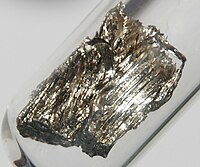
Photo from wikipedia
Jarosite can be an important scavenger for arsenic (As) and antimony (Sb) in acid mine drainage (AMD) and acid sulfate soil (ASS) environments. When subjected to reducing conditions, jarosite may… Click to show full abstract
Jarosite can be an important scavenger for arsenic (As) and antimony (Sb) in acid mine drainage (AMD) and acid sulfate soil (ASS) environments. When subjected to reducing conditions, jarosite may undergo reductive dissolution, thereby releasing As, Sb, and Fe2+ coincident with a rise in pH. These conditions can also trigger the Fe2+-induced transformation of jarosite to more stable Fe(III) minerals, such as goethite. However, the consequences of this transformation process for As and Sb are yet to be methodically examined. We explore the effects of abiotic Fe2+-induced transformation of jarosite on the mobility, speciation, and partitioning of associated As(V) and Sb(V) under anoxic conditions at pH 7. High concentrations of Fe2+ (10 and 20 mM) rapidly (<10 min) transformed jarosite to a green rust intermediary, prior to the subsequent precipitation of goethite within 24 h. In contrast, lower concentrations of Fe2+ (1 and 5 mM) led to the formation of lepidocrocite. As K-edge XANES spectroscopy revealed some reduction of As(V) to As(III) at higher concentrations of Fe2+, while Sb L1-edge XANES spectroscopy indicated no reduction of Sb(V). The transformation processes enhanced Sb mobilization into the aqueous phase, while As was instead repartitioned to a surface-bound exchangeable phase. The results imply that Fe2+-induced transformation of As/Sb-jarosite can increase Sb mobility and exert major influences on As partitioning and speciation.
Journal Title: Environmental science & technology
Year Published: 2017
Link to full text (if available)
Share on Social Media: Sign Up to like & get
recommendations!